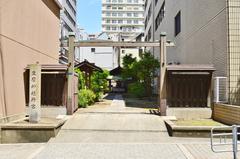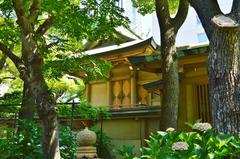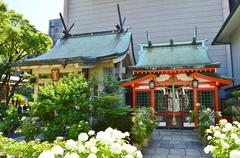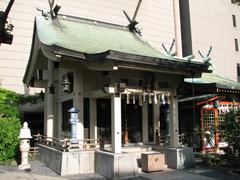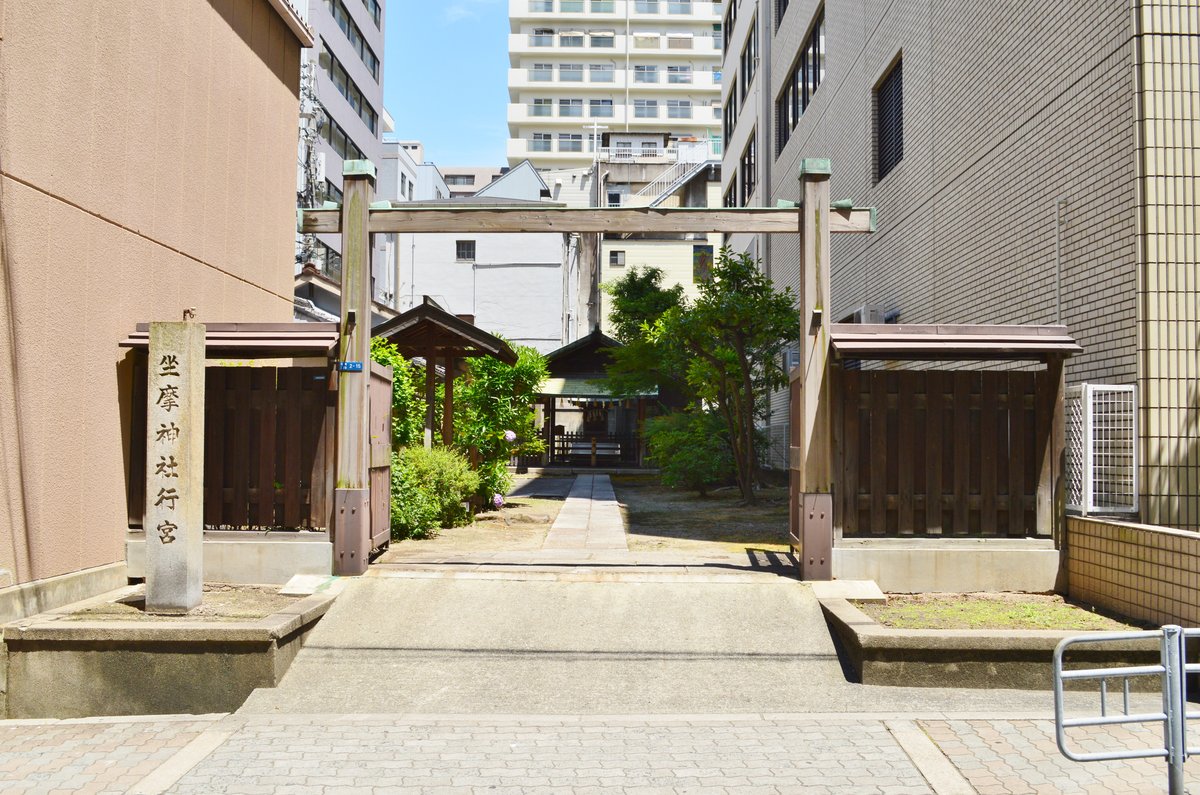
Ikasuri Shrine: Visiting Hours, Tickets, and Historical Significance in Osaka
Date: 15/06/2025
Introduction
Nestled in Osaka’s vibrant Chuo Ward, Ikasuri Shrine (坐摩神社, Ikasuri Jinja), also known as Zama Jinja or “Zama-san,” stands as one of the city’s oldest and most spiritually significant Shinto shrines. With a history stretching back nearly 2,000 years to the era of Emperor Suinin, Ikasuri Shrine is deeply woven into the cultural and urban fabric of Osaka. The shrine is revered as the protector of travelers, families, and the city itself, and offers a unique blend of ancient legend, traditional architecture, annual festivals, and spiritual tranquility. For anyone seeking to explore Osaka’s history, religious heritage, or simply a quiet retreat amid the metropolis, Ikasuri Shrine is a must-visit landmark (Osaka Info, Japan Guide).
Table of Contents
- Historical Background
- Visiting Information
- Shrine Features and Annual Festivals
- Practical Visitor Tips
- Frequently Asked Questions (FAQ)
- Nearby Attractions
- Visuals and Media Suggestions
- Summary and Further Reading
- Sources
Historical Background
Founding Legends and Early Origins
Ikasuri Shrine’s origins trace back to the reign of Emperor Suinin (circa 3rd–4th century CE), making it one of Osaka’s most ancient shrines (Osaka Info). The shrine was established by Empress Jingu, who, according to legend, prayed for safe passage after surviving a perilous sea voyage from the Korean Peninsula. In gratitude, she enshrined five protective kami—Ikui no Kami, Sakui no Kami, Tsunagai no Kami, Hahiki no Kami, and Asuha no Kami—collectively known as the Ikasuri-no-kami, guardians of travelers and the city (Rodsshinto, Wikipedia).
Role in Osaka’s Development
Strategically located in the Semba business district (Chuo Ward), Ikasuri Shrine has played a pivotal role since Osaka’s earliest days as the port city of Naniwa. It was designated as the ichinomiya (first shrine) of the former Settsu Province, underscoring its regional importance. During the Heian and Edo periods, the shrine served as a protector of merchants, travelers, and civic life, and was considered one of the Seven Great Shrines of Naniwa (Japan Guide). Its association with imperial prayers for safe childbirth and travel is documented in historical records and poetry anthologies.
Architectural Evolution
Ikasuri Shrine has undergone several relocations and reconstructions due to natural disasters and wartime destruction. The current shrine precinct was established in 1583 parallel to the construction of Osaka Castle by Toyotomi Hideyoshi. The main hall (honden), rebuilt after World War II, preserves traditional Shinto architecture, featuring unpainted cypress wood and a gabled roof. The grounds are marked by a prominent torii gate and auxiliary shrines, including the Toki Jinja, dedicated to porcelain dealers—a unique cultural addition (Osaka Info, Rodsshinto).
Visiting Information
Hours and Admission
- Open Daily: 6:00 AM to 5:00 PM
- Admission: Free (donations accepted)
- Last Entry: Typically 30 minutes before closing
Directions and Accessibility
- By Train: 5-minute walk from Hommachi Station (Osaka Metro Midosuji, Chuo, and Yotsubashi Lines), Exit 12
- By Bus: Served by several city bus lines
- By Taxi: Easily accessible from major Osaka districts
Accessibility: The shrine grounds are largely flat and wheelchair accessible, with ramps and paved paths. Rest areas and vending machines are available; accessible restrooms are nearby.
Shrine Features and Annual Festivals
Enshrined Deities
Ikasuri Shrine is dedicated to the five kami collectively known as Zamagami or Ikasuri-no-kami. They are venerated as guardians of life, fertility, family, and safe journeys. The shrine’s imperial connections are highlighted by historic prayers for safe childbirth by Empress Jingu and Emperor Meiji (Osaka Guide).
Notable Structures
- Torii Gate: Marks the sacred entrance and is often photographed, especially during festivals
- Temizuya (Ablution Pavilion): For ritual purification before worship
- Honden (Main Sanctuary): Built in nagare-zukuri style, reconstructed after WWII
- Haiden (Worship Hall): Where prayers and offerings are made
- Toki Jinja (Porcelain Shrine): Dedicated to local ceramic artisans, with unique porcelain lanterns (Rodsshinto)
Annual Festivals
- Ikasuri Matsuri (May): The main festival, featuring processions, kagura dance, and traditional rituals
- Osaka Ceramics Festival (July): Celebrates local pottery with sales, exhibitions, and the “Chawan Kuyo” (Thanksgiving for broken vessels) (Magical Trip)
- Hatsumode (New Year’s): Thousands visit for first prayers of the year and family blessings (Sparkle Travel)
- Setsubun (February 3rd): Bean-throwing ceremony to ward off evil
- Shichi-Go-San (November 15th): Blessings for children’s growth
- Reitaisai (Grand Festival, autumn): Ritual processions and sacred dances (GoGoGoshuin)
Seasonal Highlights
- Hydrangea Garden: Late May to July, offering tranquil hanami in the heart of Osaka (Lisa Eats the World)
- Cherry Blossoms and Autumn Foliage: Serene backdrop for photos and reflection
Practical Visitor Tips
- Arrive early for a peaceful visit, especially during festival days
- Photography is allowed on the grounds but avoid photographing private rituals and inside sacred buildings
- Observe etiquette: bow at the torii, purify at the temizuya, and offer coins respectfully
- Wear traditional attire (e.g., yukata) during summer festivals for an enhanced experience
- Facilities are limited; plan restroom breaks accordingly
Frequently Asked Questions (FAQ)
Q: What are Ikasuri Shrine’s visiting hours?
A: Daily, 6:00 AM to 5:00 PM.
Q: Is there an admission fee?
A: No, entry is free. Donations are welcome.
Q: How do I get to Ikasuri Shrine?
A: 5-minute walk from Hommachi Station (Osaka Metro Midosuji, Chuo, Yotsubashi Lines).
Q: Are guided tours available?
A: Guided tours are occasionally offered by local agencies; inquire at the shrine office or tourism centers.
Q: Is the shrine accessible for people with disabilities?
A: Yes, the main paths and facilities are accessible.
Q: Can I take photographs?
A: Yes, on the grounds. Please avoid photographing private rituals or interiors of the honden.
Nearby Attractions
- Osaka Castle: Iconic historical site and museum, within walking distance
- Nakanoshima Park: Scenic riverside park
- Shinsaibashi Shopping Arcade: Lively shopping and dining hub
- Sumiyoshi Taisha: Historic shrine with ancient architecture
- Shitenno-ji Temple: One of Japan’s oldest temples
Visuals and Media Suggestions
- High-quality images of the torii gate, main hall, festival scenes, and hydrangea garden
- Alt tags: “Ikasuri Shrine main hall in Osaka,” “Ikasuri Shrine visiting hours Osaka,” “Ikasuri Shrine three-torii gate,” “Ikasuri Shrine hydrangea garden”
- Interactive map showing the shrine’s location and nearby attractions
- Links to virtual tours or official photo galleries
Summary and Further Encouragement
Ikasuri Shrine eloquently bridges Osaka’s ancient past with its dynamic present, offering visitors a compelling journey through local tradition, architecture, and spirituality. Its accessibility, free admission, and proximity to major attractions make it an excellent destination for both first-time and seasoned travelers. Participate in festivals, reflect in the tranquil gardens, and capture the serene beauty through photography. For further details and updates, download the Audiala app and consult trusted travel platforms.
Reliable Sources
- Osaka Info
- Japan Guide
- Rodsshinto
- Sparkle Travel
- Magical Trip
- GoGoGoshuin
- Lisa Eats the World
- Wikipedia
- Osaka Guide
